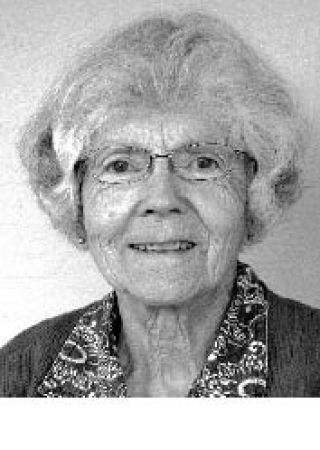“Ithink everybody needs an interest. Find your thing, enjoy it, contribute to it,” said Suzanne Nicholson.
The cloth covered walls of her entry hall exhibit one of her passions. She wove the fabric with raffia and Lopez grain and grass stems. On the stairway leading to her weaving studio, framed samples of some of her many projects verify the mastery of her craft.
Slender and agile, Nicholson wends between looms as she talks of warp and weft, shaft and treadle, cord and tie, cotton, rayon, linen and wool. “I bought the Finnish loom when I was in Italy while my husband was working there,” she said. She talks with precision about her projects, mostly practical items, of Scandinavian design and natural fiber like the intricate blue and white spread that covers her bed. It joins a multitude of blankets, table cloths, placemats, kitchen towels, curtains and wall coverings woven by Nicholson. She helped two young grandchildren create a rainbow dye pot of red, blue and yellow and layered wool in it. The colorful results are now a knitting project of teddy bears for each child.
“They are fun to do,” Nicholson said. “I’m into making memories now and documenting all of my projects so my children, grandchildren and on down the line will know they have a piece of Grandma’s weaving. The label will tell them what the fiber is and how to care for it.” She is removing items from miscellaneous storage containers and wrapping them in acid free fabric for the longevity of the weavings.
“My first experience weaving was not a happy one,” Nicholson said. “I did not like anything about it. I had to take a weaving class at the University of Puget Sound as a home economics requirement. The metal looms were noisy and we had required projects. I made a rag rug that we had for years and then it just disappeared which was no loss.”
Nicholson and her husband, Dick, both graduated from Stadium High School in Tacoma. “It was built as a hotel but when the 1890s depression occurred, the railroad no longer wanted it and the city bought it. It has been the setting for many movies because it looks like a castle.”
The Nicholsons were married in 1952 and began moving. Oakridge, Detroit, Brookhaven, Cornell, Ann Arbor, Madison and Idaho Falls all crowded Nicholson’s listing of where she has lived while following her husband’s nuclear physicist career. Frequent moves and raising four children occupied her time until 37 years ago when she rediscovered weaving in Columbus, Ohio, and bought her Swedish loom. “Like the Finnish loom, it is strong and heavy and you can weave anything on it.” She found welcoming textile groups as she moved on to new locales and continued perfecting her craft.
The couple found the San Juans 46 years ago when they rented a cabin on Orcas. Over Thanksgiving in 1974, they decided to visit all of the islands by ferry. They liked what they saw at the first stop, Lopez Island, and appreciated the quiet, non-commercial, pastoral setting. Early the next year they had their property. Dick Nicholson designed their home and did most of the building and they moved to the island in the spring of 1983. “I can hardly believe I’ll soon be 79,” she said.
“Baking bread is something I started doing in high school,” Nicholson related. By 1966, she was baking all of the family’s bread. “There is something so satisfying in producing a delicious beautiful loaf of bread. I make a triple recipe of sour dough white for my husband once a month. This produces six or more large loaves. I prefer whole wheat or rye bread, so am constantly trying new blends of whole grains. A new recipe is an adventure.”
“The first time I was at our library, it was in a little two-room school house across the street with Helen Anderson sitting at the desk. We hit it off right away,” Nicholson said. “I quickly became a volunteer. It’s interesting to see how much it’s changed.” Enthusiasm shines in her eyes that are the changing colors of sea and sky. “Many organizations on Lopez need volunteers. You are enriched and they need your help,” she added.
With no photographs of her as an infant and difficulty obtaining a birth certificate as an adult, Nicholson became curious about her parentage. After her parents were gone, she talked with family members and discovered she had been adopted but at that time, children were rarely told. She located some members of her birth family and learned that her mother died when she was six weeks old.
“I found it interesting,” Nicholson said. “That’s all. It’s a tiny dot in my past, hardly worth mentioning. I’ve had a great life.”



